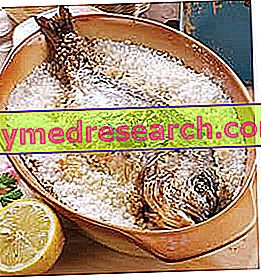Definition and mechanism - positive and negative aspects
Salt cooking is an ancient process to associate with the heat treatment in the oven. It is a variant of cooking in foil (or bag), and uses the same principle as vacuum boiling.

Variations of salt cooking
There are many variations of salt cooking. The basic procedure involves covering the product (above, below and sideways) with coarse and dry salt in proportions of 1.5kg of mineral per 1.0kg of foodstuff. The salt in contact with the food, partially dissolving by dilution in the organic fluids and drying immediately after by the action of heat, crystallizes giving shape to a more or less thick rigid shell.
Salt cooking can also be done using a coarse and fine salt mixture (the latter generally ≤50% of the total), perhaps enriched with aromatic herbs, spices and sugar, kept dry or mixed with water; for the salt cooking which involves the carving of the covering ("artistic" carving), the mixture can be integrated with egg whites and / or flour.
It is important to underline that the salt should NOT touch the private fabrics of the external covering (leather and, sometimes, scales) of fish and meat but, choosing a mixture composed ONLY of coarse salt, it is sometimes possible to exploit it also on cut products "in vivo" as loins and fillets; obviously, at the end of the process, it will be the operator's responsibility to carefully remove all the mineral residues.
Temperatures and times in cooking fish and meat with salt
Salt cooking is carried out at rather high temperatures, generally between 180 and 200 ° C (when the oven is already hot). For a correct estimate of the times (as it is not possible to evaluate the food consistency in the presence of the cap), it is advisable to calculate about 30 'per kg of weight of the fish; for meat the timing is greater: about 40 '/ kg in cooking with blood and up to 50' for complete ones. Recall that both the shape and the possible presence of bones can change the duration of the cooking increasing it significantly.
" Personally I always use a mixture of coarse salt, salt mixed with water and whipped egg whites ".
Discover Our Video Recipe - Sea Bream in Salt Crust



